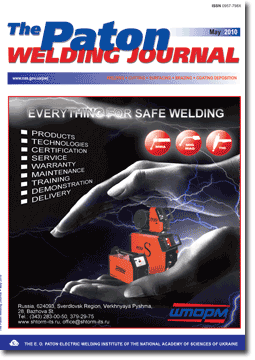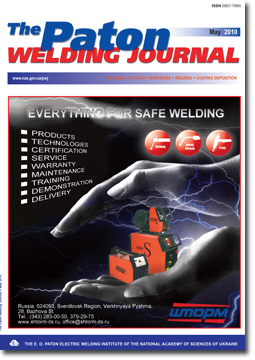| 2010 №05 (10) | 2010 №05 (02) |

TPWJ, 2010, #5, 5-9 pages
PROBABLE MECHANISM OF CRACKING OF STABLE-AUSTENITIC WELDS CAUSED BY OXYGEN SEGREGATION
Journal The Paton Welding Journal
Publisher International Association «Welding»
ISSN 0957-798X (print)
Issue № 5, 2010 (May)
Pages 5-9
Authors
K.A. YUSHCHENKO, V.S. SAVCHENKO, N.O. CHERVYAKOV and A.V. ZVYAGINTSEVA
E.O. Paton Electric Welding Institute, NASU, Kiev, Ukraine
Abstract
Current concepts of the nature of formation of cracks classified as ductility-dip cracks in multilayer welds or HAZ of steels and alloys with single-phase structure have been reviewed. It is noted that the mechanism of formation of such cracks is a subject of discussion. A hypothesis of the probable influence of oxygen on the processes of intergranular fracture is set forth, as oxygen decreases cohesion strength of grain boundaries in the established temperature range and leads to intergranular fracture.
Keywords: arc welding, high-alloy steels, nickel alloys, welded joints, grain boundaries, ductility-dip cracks, cohesion energy, Auger-spectroscopy
Received: ??.??.??
Published: 28.05.10
References
1. Collins, M.G., Lippold, J.C. (2008) An investigation of ductility dip cracking in nickel-based filler materials. Pt 1. Welding J., 82(10), 288-295.
2. Young, G.A., Capobianco, T.E., Penik, M.A. et al. (2008) The mechanism of ductility dip cracking in nickel-chromium alloy. Ibid., 87(2), 31-43.
3. Capobianco, T.E., Hausou, M.E. (2005) Auger spectroscopy results from ductility dip cracks opened under ultra-high vacuum. In: Proc. of Int. Conf. on Trends in Welding Research (16-18 May, 2005, Callaway Giardens Resort, Pine Mountain, Georgia, USA), 767-772.
4. Lippold, J.C., Nissley, N.E. (2007) Further investigations of ductility dip cracking in high chromium, Ni-base filler metals. Welding in the World, 9/10, 24-30.
5. Noecker, F.F., DuPont, J.N. (2009) Metallurgical investigation into ductility dip cracking in Ni-based alloys. Pt 2. Welding J., 3, 62-77.
6. Nishimoto, K., Saida, K., Kiuchi, K. et al. (2008) Hot cracking behaviour of high-purity type 310 stainless steels. Material joining process. IIW Doc. IX-H-G98-08.
7. Yushchenko, K., Savchenko, V. (2008) Classification and mechanisms of cracking in welding high-alloy steels and nickel alloys in brittle temperature ranges. In: Hot cracking phenomena in welds II. Berlin, Heidelberg: Springer, 95-114.
8. Pang, Y.-W., Altstetter, G.I. (1987) The diffusion and solubility of oxygen in solid nickel. Metal. Transact. A, (7), 43-50.
9. Rickert, H., Steiuer, R. (1966) Elektrochemische Messung der Sauerstoffdiffusion in Metallen bei hoeheren Temperaturen.
Zeitschrift fuer Physikalische Chemie, 49(3-5), 127-137.
10. Pietscyhmann, G., Noky, D. (1988) Anwendung des Sauerstoffpotentials-messtechnick in der Stahlwerk Praxis. Neue Huette, 6, 210-214.
11. Bester, H., Lange, K.W. (1972) Abschaetzung mittlerer Werte fuer die Diffusion von Kohlenstoff, Sauerstoff, Wasserstoff, Stickstoff und Schwefel in festem und fluessigem Eisen. Archiv fuer das Eisenhuettenwesen, 3, 207-213.
12. Yamaguchi, W. (2008) First-principles calculations of the grain-boundary cohesive energy Д embrittling or strengthening effect of solute segregation in a bcc Fe.3(111) grain boundary. J. Japan Inst. of Metals, 72(9), 658.
13. Hippsley, S.A., Rauh, H., Bullongh, R. (1984) Stress-driver solute enrichment of crack-tips during low-ductility intergranular fracture of low-alloy steel. Acta Metallurgica, 32(9), 1381-1394.
14. Hondros, E.D., Seah, M.P. (1977) Segregation to interfaces. Int. Metals Rev., 12, 288-292.
15. Zhebynev, D.A., Ukolova, O.G., Gelman, A.A. et al. (1985) Study of chemical composition of diffusion zone in solid phase Ti-6 % Al-4 % V alloy joint. Method of scanning Auger spectroscopy. Fizika i Khimiya Obrab. Materialov, 6, 108-114.
16. King, H.W. (1982) Atomic size parameters for the elements. J. Phase Equilibria, 2(4), 527.
17. Dico, P., Ocelik, V., Hajko, V. et al. (1987) Porusovanie pasok kovovych skiel pri monotonnom Tahovom zatazovani. Kovove Materialy, 25(5), 523-536.
The cost of subscription/purchase order journals or individual articles
| Journal/Currency | Annual Set | 1 issue printed |
1 issue |
one article |
| TPWJ/USD | 384 $ | 32 $ | 26 $ | 13 $ |
| TPWJ/EUR | 348 € | 29 € | 24 € | 12 € |
| TPWJ/UAH | 7200 UAH | 600 UAH | 600 UAH | 280 UAH |
| AS/UAH | 1800 UAH | 300 UAH | 300 UAH | 150 UAH |
| AS/USD | 192 $ | 32 $ | 26 $ | 13 $ |
| AS/EUR | 180 € | 30 € | 25 € | 12 € |
| SEM/UAH | 1200 UAH | 300 UAH | 300 UAH | 150 UAH |
| SEM/USD | 128 $ | 32 $ | 26 $ | 13 $ |
| SEM/EUR | 120 € | 30 € | 25 € | 12 € |
| TDNK/UAH | 1200 UAH | 300 UAH | 300 UAH | 150 UAH |
| TDNK/USD | 128 $ | 32 $ | 26 $ | 13 $ |
| TDNK/EUR | 120 € | 30 € | 25 € | 15 € |
AS = «Automatic Welding» - 6 issues per year;
TPWJ = «PATON WELDING JOURNAL» - 12 issues per year;
SEM = «Electrometallurgy Today» - 4 issues per year;
TDNK = «Technical Diagnostics and Non-Destructive Testing» - 4 issues per year.


